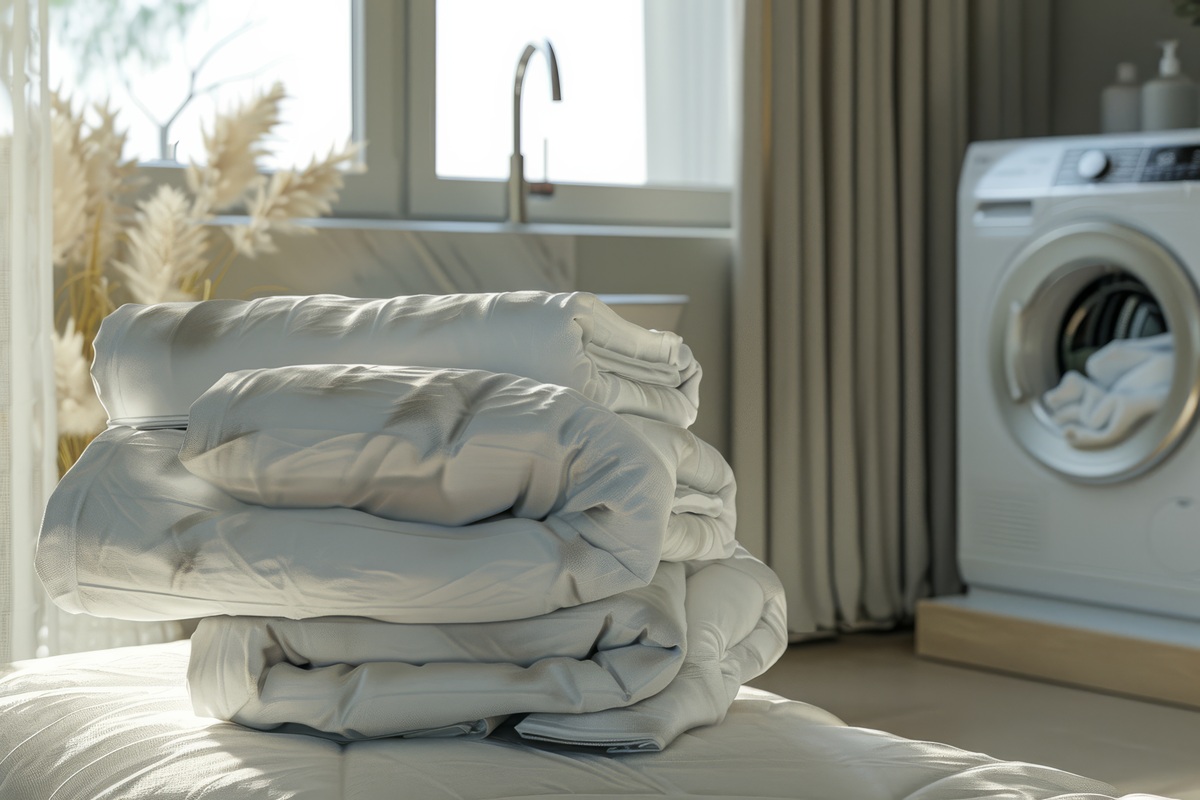When it comes time to care for your bedding, you may find yourself facing a major challenge: your comforter simply doesn’t fit in your washing machine. Too bulky, too thick, it refuses to bend to your efforts. In light of this, many consider the quick but costly solution of dry cleaning.
However, there is a straightforward method to wash your comforter at home, without spending a fortune or sacrificing your comfort.
You will see that with a little organization and some well-chosen steps, it is quite possible to have a fresh, clean, and inviting comforter without stepping foot in a laundromat.
Preparing Your Comforter Before Washing
Before thinking of giving your comforter a bubbly bath, it’s essential to take a few minutes to prepare it properly. Start by airing it out by vigorously shaking it outside. This helps remove a significant amount of dust as well as the invisible dust mites that may be lurking within.
If possible, vacuum the entire surface with a brush suitable for fabrics. This preliminary action considerably lightens the washing workload and optimizes the soaking process you will do later.
Don’t hesitate to check the labels on your comforter. Some materials, like down or natural fibers, require special care, particularly regarding water temperature.
Hand Washing: Your Best Ally
When your machine lacks capacity, your bathtub becomes your best ally. Fill it generously with lukewarm water—avoid using very hot water, as it could damage the filling—and add a mild detergent, ideally formulated for delicate fabrics.
Submerge your comforter completely in the water, making sure to distribute it evenly so it absorbs moisture uniformly. Allow it to soak for a good hour, letting the ingrained dirt gently loosen from the fibers.
During this phase, gently press the comforter underwater with your hands to circulate the detergent and ensure a thorough cleaning. Focus delicately on the most exposed areas, such as the edges or center, which often show more wear from usage.
Rinsing for Impeccable Results
After this long soak, comes the equally crucial moment of rinsing. Completely empty the bathtub and rinse the comforter with clear water. It’s essential to repeat this operation several times, as soap residues could compromise the fabric’s quality and cause skin irritation during use.
To facilitate rinsing, you can let a thin stream of water flow while gently pressing the comforter against the side. Patience is your best ally here; a rushed rinse will undo all your efforts.
As for the spinning process, do it gently. Resist the urge to twist your comforter harshly. Opt for the gentle method: press it against the wall to let the water flow out without damaging the fibers or distorting the filling.
Drying: A Key Step to Avoid Surprises
Drying is undoubtedly the most crucial step to ensure the longevity of your comforter. Ideally, lay it flat on a large drying rack or sturdy line in a well-ventilated outdoor space. The sun is your best ally for quick and natural drying and has the added benefit of sanitizing the fabric due to its antibacterial properties.
If the weather doesn’t cooperate, place your comforter in a well-ventilated room, remembering to turn it regularly to avoid moisture stagnation inside.
No Bathtub Available? Here’s An Alternative Solution
Lacking a bathtub doesn’t mean you can’t wash your comforter effectively. Several simple solutions are available.
The first option is to use a large basin or shower tray. Choose a container as wide as possible: a large gardening basin, a clean storage bin, or even a spacious walk-in shower can work perfectly. Fill the container with lukewarm water and mild detergent, then submerge your comforter as you would in a bathtub. The key is to thoroughly saturate all the fibers with soapy water, even if you have to do it in several stages or wash the comforter by sections.
If you have access to an outdoor space, . Lay your comforter flat on a clean tarp or directly on well-cleaned tiles. Soak the comforter thoroughly with a garden hose, apply the detergent, and gently scrub with a soft brush, paying extra attention to the dirtiest parts. Rinse thoroughly until the water running off is perfectly clear.
In both cases, you’ll need to be a bit more patient with rinsing and spinning. Always press your comforter gently to remove excess water without risking damage to the fibers or crushing the filling.
Finally, the drying recommendations remain the same: lay your comforter in a well-ventilated area, ideally outdoors, and turn it regularly for even drying.
Caring for Your Comforter to Space Out Washes
Good daily care is essential to avoid having to wash your comforter too frequently. Using a protective cover is a simple yet extremely effective gesture. It traps dust and sweat marks, thus prolonging your comforter’s freshness.
Also, remember to air it out frequently by exposing it to fresh air. Even just placing it in front of an open window for a few hours can work wonders.
If you are prone to allergies or have pets, it is recommended to wash your comforter more often, without necessarily waiting for odors or visible stains to appear.
Even without access to a large-capacity machine, you can very well wash your oversized comforter at home. By following these simple steps, you will restore freshness and comfort to your bedding while making significant savings. No need to schedule a trip to the dry cleaners: your bathtub and a little patience are more than enough.
I’m a disabled, xennial Christ-follower, slightly off kilter (but aren’t all “ar-teeests”?).
Hope you enjoy my rantings, don’t take my sarcasm too seriously and know that comments are welcome. 🙂


Leave a Reply